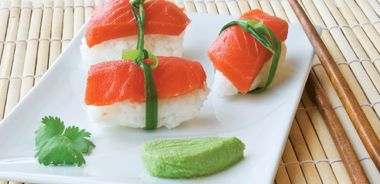Salmon Nigiri

A classic that’s equally delicious with tuna, shrimp, mackerel, mahi-mahi, sea bass, flounder, and sole. Wild Pacific salmon is a less contaminated, more eco-friendly choice than farmed salmon.
5 oz (142 g) sushi-grade salmon fillet
1 1/2 tsp (7 mL) wasabi paste
8 rounded Tbsp (120 mL) sushi rice, cooked (see recipe here)
1/8 cup (30 mL) soy sauce
Pickled ginger (optional)
Cut salmon across the grain at a slight angle into 8 thin, equally sized pieces (about 1 x 2 in/3 x 5 cm). Spread a bit of wasabi down the centre of each piece of salmon.
Moisten your hands with a water-vinegar mixture and squeeze small balls of rice into 8 rectangular shapes. Place a salmon slice in the palm of one hand, wasabi side up. Place a rice block on top of salmon. Use thumb and index finger of your opposite hand to gently press in the sides and use the other thumb to lightly press it down. Flip salmon block into other palm and repeat.
Serve with soy sauce and ginger. Makes about 8 pieces.
Each 4-piece serving contains: 194 calories; 20 g protein; 3.5 g fat (1 g sat. fat, 0 g trans fat); 19 g carbohydrates; 1 g fibre; 700 mg sodium
source: "Easy Make-at-Home Sushi", alive #323, September 2009





